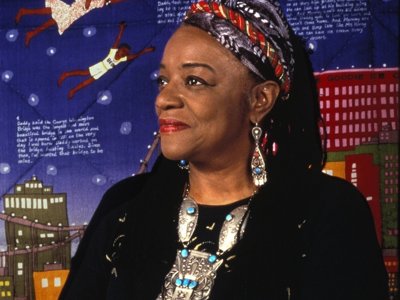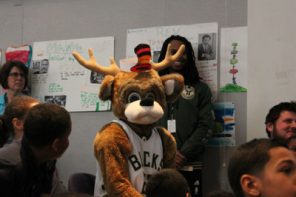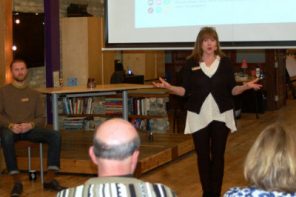The day just got cooler today at two MPS schools. This morning, renowned author and artist Faith Ringgold read her 1992 Caldecott-winning children’s book “Tar Beach” to students at Hampton Elementary School. Then tonight at 6, Ringgold will give a public lecture at North Division High School.
The two events coincide with the new “Stories Shared” exhibit on display at Arts @ Large, 908 S. 5th St., which features 20 pieces of Ringgold’s artwork, illustrations and quilts.
OnMilwaukee got a chance to quick sit down with the award-winning author and artist – who has her next book, “Harlem Renaissance Party,” coming next year – and chat about her lecture this evening, “Tar Beach” and the importance of sharing stories.
OnMilwaukee.com: What was it like adapting “Tar Beach” as your first novel, both writing and illustrating it?
Faith Ringgold: Well, the real story is “Tar Beach” was a quilt before it became a book. That’s how the story got written. I had written my autobiography in 1980 and had decided that I was going to make quilts and write my story on them because I couldn’t get my autobiography published.
I also noticed that when I made these big paintings into quilts, I could carry them around. I could ship them easily. People would stand there and read the words. And I mean actually read the whole thing, and if they didn’t get it all read, they’d come back and finish it. I was shocked because I thought, “Who’s gonna stand up there and read all of that?”
OMC: Why do you think that is with a quilt that had that power?
FR: I don’t know. I don’t think just writing on a painting that is framed has that power, no. I don’t know why. But the quilt does.
OMC: What was it like having adapting this quilt and having to expand upon it, especially visually?
FR: I had written it at first as a series of quilts. There’s five of them, and the first one I did was for a musician named Sonny Rollins. He used to go up on the bridge to blow his horn, and I thought that was fabulous. Somebody going up on a bridge because you can’t do it in an apartment in New York because the neighbors are gonna complain, so you go up on the Brooklyn Bridge and blow your horn.
And I said, boy, it seems like there could be a whole series of paintings like that attributed to women who do things like that because they can’t get over doing this way, so they do it that way. So I said I’d do a series called “Woman on a Bridge,” and “Tar Beach” was my first in 1988.
When I did it, I did it for an exhibition also at Bernice Steinbaum’s gallery, and she said to do one early so she could show it to promote the show. I did the “Tar Beach” one, and this woman who makes pocketbooks – beautiful, jeweled pocketbooks – Judith Lieber, she bought “Tar Beach” before the show even began and asked Bernice what she could do for this artist.
Bernice said why don’t we try to get her into some museums. What about the Met? What about the Guggenheim? So I said you two have gone crazy. I don’t want anything to do with this. (laughs) But it turned out the Guggenheim said yeah, come on in. So it’s in the Guggenheim now.
OMC: How’d it make the leap from there to a children’s novel?
FR: So this woman from Random House goes in her doctor’s office, and Bernice has made posters out of this quilt, all around in different offices and stuff. She’s an editor at Random House, and she reads the story. I didn’t really know whether people would stand up there and read the story or not, but I just said I’m not going to let anybody keep me from publishing. I’m going to do it.
She read it, and she said that it would make a very good children’s book. I said, “Really?” I didn’t even know it was a children’s book, except I did know that, when you write something, you put yourself in that frame of mind. So I was writing about my childhood, so I put myself in that frame of mind. So it’s a children’s book.
OMC: Do you know what you’re lecturing about tonight?
FR: Me! I use PowerPoints of my art to guide me through my life’s story. Because that’s what the art is about; it’s about me and what I think and what I’ve done about it. (laughs)
OMC: Do you have any tips of advice out there for any fledgling or young artists or authors out there?
FR: Tell your story. Just keep telling it. That’s what artists do anyway: They tell their story. They may not say it that way, but that’s essentially what they’re doing. You can’t tell about something you don’t know anything about. So it has to be you in some way. Even if it’s the magic of color or however abstract you make it, it’s you, and you’re sharing it with the world.
OMC: That ties in really nicely with the theme of this whole exhibit, the idea of shared stories. What does that concept mean to you?
FR: Oh absolutely. I grew up on that. People used to come and visit my mother and father, and they would bring their stories of how they left their home and travelled here and there and how they got there and what happened on their way. I used to sit there as a kid and listen to them and their stories. It was fascinating to me.
People don’t do it as much today. I don’t know why. They don’t have time anymore, I guess.
OMC: And then there’s the Internet.
FR: Yeah, the Internet’s another thing. But yeah, everybody came to see us, and everybody talked. People were always engaging in conversation, telling the story of how they got from here to there or what they did yesterday. And that, to me, was always fascinating because I, frankly speaking as a child, couldn’t figure out how they knew so much and knew so many people’s names and events.
I could sit there and listen as long as I didn’t become a nuisance because then I would have to go to bed. (laughs) So I was very careful that I didn’t become a nuisance so I could hear these stories. It was later when I became an artist that I realized that my art could be, and would be, my story.


 i evaluate to yes even if there's no image
i evaluate to yes even if there's no image  i evaluate to yes even if there's no image
i evaluate to yes even if there's no image  i evaluate to yes even if there's no image
i evaluate to yes even if there's no image  i evaluate to yes even if there's no image
i evaluate to yes even if there's no image  i evaluate to yes even if there's no image
i evaluate to yes even if there's no image  i evaluate to yes even if there's no image
i evaluate to yes even if there's no image 